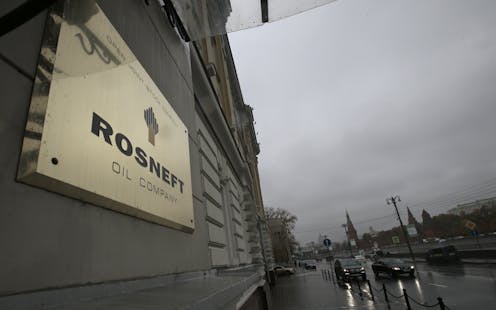The US is banning Russian oil imports, but an embargo that includes European allies would have more
Oil revenues are crucial to Russia’s economy. The US only accounts for a small fraction of them, so banning Russian oil imports has mainly symbolic value.

President Joe Biden announced on March 8, 2022, that the U.S. will ban imports of oil from Russia, along with refined petroleum products, natural gas and coal. The ban is the latest U.S. action designed to punish Russia for its invasion of Ukraine. Global energy policy expert Amy Myers Jaffe explains how this step is likely to affect oil prices – and Russia.
How important is Russia as a US oil supplier?
Russia produces close to 11 million barrels per day of crude oil. It uses roughly half of this output for its own internal demand, which presumably has increased due to higher military fuel requirements, and it exports 5 million to 6 million barrels per day.
Today, Russia is the second largest crude oil producer in the world, behind the U.S. and ahead of Saudi Arabia, but sometimes that order shifts. Russia earned over US$110 billion in 2021 from oil exports, twice as much as its earnings from natural gas exports.
For the U.S., Russia is a relatively small oil source. In 2021 it provided 8% of U.S. imports of crude oil and petroleum products. At times in recent years that share has increased, after events such as sanctions on Venezuela and storms that disrupted offshore production last year in the U.S. Gulf of Mexico.
But Russian crude oil is not really a baseload staple for U.S. refiners. Purchases were down to 84,000 barrels per day when the Biden Administration formally announced the import ban. It will be a minor inconvenience for U.S. refiners to avoid Russian oil.
And the reverse is also true: U.S. purchases barely register on Russia’s massive oil earnings. To be effective, individual country bans must be aggregated across many countries to produce consequences that actually affect the Russian purse.
What about other countries that buy Russian oil?
The challenge to institute similar bans is much harder for Europe. The United Kingdom, which is an oil producer, is also banning Russian oil imports, but getting other G-7 nations like Germany, Italy and Japan to join will be a hard diplomatic lift. It’s not impossible, but Germany – the largest economy in Europe – currently is holding off, though it is making plans to find alternatives.
About half of Russia’s exported oil is shipped to European countries, including Germany, Italy, the Netherlands, Poland, Finland, Lithuania, Greece, Romania and Bulgaria. China is another large buyer: It imports 1.6 million barrels per day of Russian crude oil.
It remains to be seen whether China will take any extra Russian oil, which is likely to be highly discounted, and swap it out by releasing other barrels that could be scooped up by European refiners. India has already bought Russian crude cargoes at a sharp discount.
Since oil is a relatively fungible global commodity, at least some of Russia’s crude exports to Europe and other countries that may choose to join the U.S. and U.K. in imposing oil sanctions may wind up being sent somewhere else. That would free up other supplies from sources such as Norway, Angola and Saudi Arabia to be redirected back to Europe.
Russia’s oil has high sulfur and other impurities, so refining it requires specialized equipment – it can’t be sold just anywhere. But other Asian buyers can take it, including India and Thailand.
Can European nations get oil from other sources?
Europe and the U.S. could simultaneously increase crude oil sales from their national strategic stocks to lessen the blow of any further restrictions on Russian crude oil imports to the G-7. The U.S. is already selling 1.3 million barrels per day from its Strategic Petroleum Reserve and has said it will increase these flows. China has also released oil from its national strategic stocks to help ease oil prices.
Still, determining how much strategic oil to release at once depends on perceptions about the duration of the conflict and whether it could escalate beyond Ukraine. Those are both unknowns.
The U.S. and other G-7 members also could ask Middle East countries to relax destination restrictions on their crude oil shipments, and press countries like China and India to redirect other oils of similar quality to Russian oil back to Europe if and when they increase their purchases from Moscow. Such steps would help ameliorate additional upward price impact of any future G-7 restrictions on Russian oil imports.
It’s not certain that China and India would cooperate, but it would be in their interests to do so. They are major oil importers and would not want to see higher crude oil prices.

How are reduced oil purchases from Russia likely to affect world oil prices?
One effect is already clear: Markets have anticipated possible energy sanctions on Russia by discounting Russian crude. Refiners who aren’t obligated by firm legal contracts to take delivery of it are shunning spot, or non-contract, cargoes exiting Russian ports.
One trade publication estimates that this has resulted in roughly 1.6 million barrels per day of Russian oil failing to find buyers The result is a large-scale disruption in global oil supplies that is already boosting prices, even though the physical oil is still available in principle.
There’s a limit to how much oil is available to replace lost Russian crude exports. Most exporters are maxed out in terms of crude oil production, but a few of the largest Middle East producers could surge their output in the short term to put an extra 1 million barrels per day or more onto the market.
The Biden administration has been continuing talks with Iran to restart the nuclear deal suspended by President Trump in 2018. If that happens, Iranian oil exports might rise from 800,000 barrels per day now to about 1.5 million barrels per day within three months or so.
But Russia is a party to the nuclear deal and has demanded guarantees that its economic trade with Iran will be exempt from any sanctions associated with Russia’s invasion of Ukraine. That demand has slowed diplomatic progress.
Saudi Arabia has access to large stores of crude oil in its vast global tank system and its tankers that float at sea. In 2014, when Russia invaded Crimea, U.S. allies in the Persian Gulf held over 70 million barrels in storage near Fujairah in the United Arab Emirates. They did this as a threat to Russia that a price war would ensue if Russian troops moved beyond that peninsula. Russia stayed in Crimea, so the oil was not released.
[Over 150,000 readers rely on The Conversation’s newsletters to understand the world. Sign up today.]
The Saudis have launched price wars that hurt Russia’s economy before, in 1986, 1998, 2009 and again briefly in 2020. But today’s oil market conditions make a price war an unlikely outcome, given the existing tight balance between supply and demand. The only scenario that could trigger a price war now would be if global demand were to contract suddenly because of a recession.
This is an update of an article originally published on March 1, 2022.
Amy Myers Jaffe does not work for, consult, own shares in or receive funding from any company or organization that would benefit from this article, and has disclosed no relevant affiliations beyond their academic appointment.
Read These Next
The Bible says little about Jesus’ childhood – but that didn’t stop medieval Christians from enjoyin
Legends about Jesus’ early years that circulated in medieval Europe often drew on apocryphal texts.
Data centers need electricity fast, but utilities need years to build power plants – who should pay?
How many data centers will be built – and how much electricity they’ll need – is uncertain. Being…
Black-market oil buyers will push Venezuela for bigger discounts following US seizure – starving Mad
Venezuela relies on the black-market oil trade for a large chunk of its revenue. US enforcement actions…






